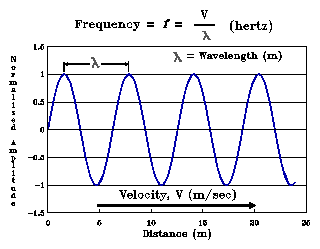
Perhaps the most familiar part of the electromagnetic spectrum is the Visible Light Spectrum. The light with which you are reading this page is, in reality, radiation covering part of the electromagnetic spectrum. In fact, the term "spectrum" was originally limited to light. The great physicists of the 17th through 19th centuries were the first to realize that what we think of as white light is really a broad range of different colors of light from the brightest red at one end to the deepest purple at the other. Thus, white light is a spectrum of different colors.

Light exhibits properties of waves and can be focussed and bent like waves in a pond. Just as a wave traveling through water has a wavelength (the distance between wave crests) and a frequency (the number of wave crests passing a point in a unit of time), light has a wavelength and a frequency. Red light has the longest wavelength and lowest frequency while purple light has the shortest wavelength and highest frequency.
The electromagnetic spectrum extends in both directions from the visible range. Shorter-wavelength, higher frequency "light" includes ultraviolet, x-rays, and cosmic rays. Longer-wavelength, lower-frequency "light" includes first infrared light then, as wavelengths become longer and longer, radio waves. The early physicists also found that electrons travelling through wires are surrounded by both electric and magnetic fields, and that a wire carrying an alternating current is surrounded by electric and magnetic fields varying in intensity at the same frequency as the electric current. Furthermore, the wire radiates energy that propagates just as do light waves with a frequency and wavelength corresponding to the frequency of the alternating current in the wire.
The basic developments of Hertz and Marconi in the waning years of the 19th century preceded radio transmission of voice and music signals by only a decade. Commercial broadcasting began in 1920 when KDKA in Pittsburgh was granted a license. All that was required to use radio techniques for these purposes was to develop ways to achieve the following: first, add the voice or music signals to a suitable alternating current called the carrier (modulating the carrier with the information signal); second, generate an electromagnetic wave capable of detection at a distant site using Hertz's and Marconi's findings; third, remove the information signal from the carrier (demodulating the carrier); and finally, convert the electrical signals to sound waves that the listener can hear. These technical achievements were being pursued in the telephone and recording industries, and thus, were quickly available for broadcasting.

|
To be contacted for a confidential consultation please E-mail: jmatk@tscm.com
or send a letter via US Mail to:
or call:
URL: http://www.tscm.com/ |